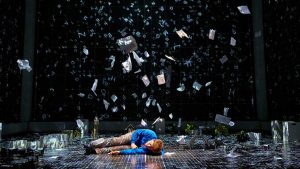Gielgud Theatre, London
Reviewed on April 12, 2017

First published in 2003, The Curious Incident Of The Dog In The Night – Time is a best – selling novel by Mark Haddon.
Equally popular world – wide with adults and children alike, I was fascinated to learn that the book was initially and intentionally marketed with both distinct groups in mind. Raking up more than two million sales since its release fourteen years ago, Haddon’s work went on to win such prestigious awards as the Boeke Prize, Whitbread Book Of The Year, and the Guardian Children’s Fiction Prize. When the possibility arose to turn The Curious Incident Of The Dog In The Night – Time into a live play, even Haddon couldn’t imagine how attempting it would be humanly possible. He also went on record to declare his creation, ‘unstageable’.
Fortunately for fans of the book, a group of brave visionaries took the risk and their mission paid off.
London’s National Theatre, in tandem with Simon Stephens’ brilliant adaptation, and Marianne Elliot’s sensitive direction, have built a show for the ages. This immersive journey fuses a gripping plot with some stellar special effects. Further, first – rate performances from the entire cast, are faultlessly combined with the creative team’s stunning production design.
Adding to an unforgettable viewing experience, is that the props and pyrotechnics do not overpower an emotionally – charged story. Instead, the actors use these devices as a launching pad to fully invest themselves in the dramatic narrative arc.
Premiering at London’s Royal National Theatre in 2012, since then, productions have operated in Belgium, Canada, Japan, Korea, Mexico, and the United States of America. The show also claimed numerous accolades, sweeping the Olivier Awards, Drama Desk Awards and Tony Awards, for categories including Best Play, Best Director, and Best Actor.
This time last year, I was fortunate enough to attend an evening performance at the Ethel Barrymore Theatre on Broadway. Seizing the opportunity to catch it again, I had to be quick. The Gielgud Theatre’s version I saw last week on Shaftsbury Avenue, wraps up its West End run in June.
Put simply, the story is about a socially – challenged young man and his place in the world. Though Hadden never once mentions the source of this struggle in his original text, based on what we take in, the protagonist either has a form of high – functioning autism or Asberger’s Syndrome.
Though the causes and the cures for each affliction are still unknown, interventions include cognitive behavioural therapy, physical therapy, speech therapy, and medications prescribed to treat mood swings and anxiety attacks.
Our hero, Christopher John Francis Boone, also happens to be a mathematics genius.
The story begins, when he discovers a neighbour’s dog stabbed to death with a pitchfork. Shortly thereafter, the fifteen – year old uses his innate gift to set about solving the crime. Along the way, Boone stumbles through a sea of red herrings and false leads, as well as discovering the shocking truth behind a recent family tragedy.
Through all of this, the main character somehow adapts to the adult world and its daily pitfalls as well. Honest to a fault, the clincher is that in order to get what information he needs, Boone must also learn how to lie.
In her care, Elliot’s vision was to make audiences breathe the same air as Christopher. In essence, the story takes place completely inside his head.
However, rather than following the book in first – person narrative, here, the play is brought to life as a reading of Boone’s own writing. Spoken aloud in small portions by his therapist, the end result becomes both a reimagined and deconstructed play within a play.
From a technical viewpoint, how this is achieved makes The Curious Incident Of The Dog In The Night – Time nothing less than mind – blowing.
Bunny Christie’s set is a gigantic grid, marked out using x, y and z axes. Within that black and white framework, secret compartments, lighting (by Paule Constable) and elaborate video projections (by Finn Ross) really do allow us to see the world through Boone. Music by Adrian Sutton, sound by Ian Dickinson (for Autograph) and movement by Scott Graham and Stephen Hoggett (for Frantic Assembly), make this a total sensory pleasure.
At times, the actors also take on secondary roles as machines and other devices. Either becoming doorways and appliances, or in one hilarious instance, a rather seductive automatic teller machine.
In my experience, theatre stagecraft has been taken to a new level of genius.
When I saw the show on Broadway, the cast was mostly made up of American actors affecting British accents. (I only know that because they talked with the audience after the show, raising funds for a charity called Broadway Cares – Equity Fights AIDS).
Being the skilled professionals they were, the difference between that occasion and the ‘real thing’ was negligible. The bottom line, is this play shows everyday people coping with life (or not), all functioning under tremendously stressful circumstances.
The afternoon I attended, Thomas Dennis was exceptional as Boone. How the actor was able to sustain the level of intensity needed to stay in character, made his work all the more impressive. He was matched by Nicholas Tennant (who played Boone’s long – suffering father, Ed), Jo Castleton as Siobhan (Boone’s therapist, mentor and para – professional), and Sarah Stanley as Judy (Boone’s absent mother).
Whether the show comes to Australia, is still unknown at this point.
Until that possibility materialises, a live taping was made and screened globally several years ago, which I believe played at Cinema Nova in Carlton. Hopefully, a repeat viewing will happen soon.
Image Source: Blouin Artinfo
